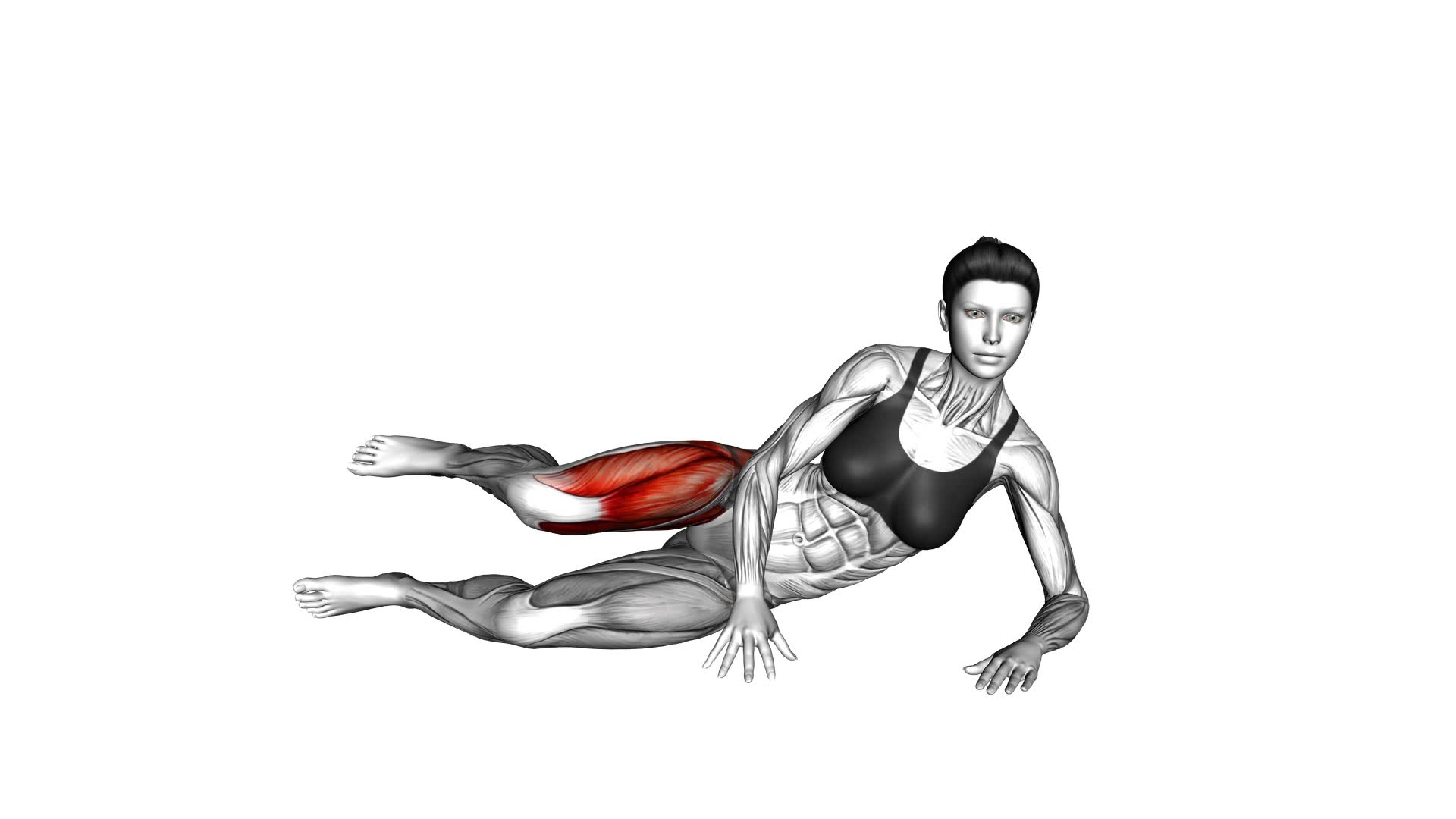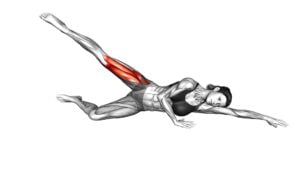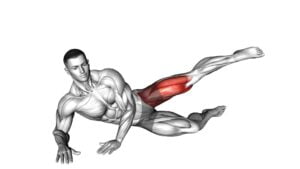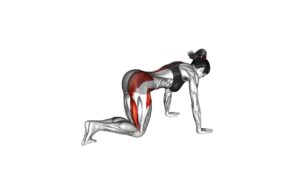Side Lying Knee Circle Kick (female) – Video Exercise Guide & Tips

Are you looking for a challenging exercise to strengthen your lower body?
Watch This Exercise Video
Look no further than the side lying knee circle kick!
In this video exercise guide, we will show you the proper form and technique for this move.
You'll also learn common mistakes to avoid and modifications to make it more challenging.
Get ready to kick your way to stronger legs with the side lying knee circle kick!
Key Takeaways
- Side Lying Knee Circle Kick improves flexibility in the hips.
- Side Lying Knee Circle Kick strengthens glutes, hip flexors, and thigh muscles.
- Side Lying Knee Circle Kick helps alleviate lower back pain.
- Side Lying Knee Circle Kick reduces the risk of injury.
Benefits of Side Lying Knee Circle Kick
To maximize the effectiveness of your workout routine, incorporating the Side Lying Knee Circle Kick can provide numerous benefits. This exercise isn't only great for improving flexibility but also for strengthening your hip muscles. The Side Lying Knee Circle Kick targets the glutes, hip flexors, and thigh muscles, helping to increase their strength and stability.
By performing the Side Lying Knee Circle Kick regularly, you can enhance the flexibility of your hip muscles. This is particularly important for activities that require a wide range of motion in the hips, such as dancing, martial arts, or sports like soccer and basketball. Improved flexibility in the hips can also help alleviate lower back pain and reduce the risk of injury.
Additionally, the Side Lying Knee Circle Kick helps to strengthen the hip muscles. Strong hip muscles are essential for maintaining proper posture, stability, and balance. They play a crucial role in supporting the spine and pelvis, which can prevent issues like hip impingement and instability.
In the next section, we'll discuss the proper form and technique for performing the Side Lying Knee Circle Kick to ensure that you get the most out of this exercise and avoid any potential injuries.
Proper Form and Technique for Side Lying Knee Circle Kick
To perform the Side Lying Knee Circle Kick correctly:
- Start by lying on your side.
- Bend your bottom knee for stability and extend your top leg in front of you.
- Keep your top foot flexed and your toes pointing forward.
- Place your top hand on the floor in front of you for support, while your other hand can rest on your hip.
To execute the knee circle kick:
- Begin by lifting your top leg slightly off the floor.
- Engage your core muscles to maintain stability and control throughout the movement.
- Make small circles with your top leg, starting with clockwise rotations.
- Focus on using your hip joint to initiate the movement, while keeping your leg straight and maintaining control.
- After completing several rotations in one direction, switch to counterclockwise rotations.
For modifications:
- You can perform the side lying knee circle kick with a resistance band around your ankles to add extra resistance and challenge.
- To progress, you can increase the size of the circles or add ankle weights.
By mastering the proper form and technique of the side lying knee circle kick:
- You can effectively target your hip abductors and improve your overall lower body strength and stability.
Now let's move on to the common mistakes to avoid during this exercise.
Common Mistakes to Avoid During Side Lying Knee Circle Kick
When performing the side lying knee circle kick, it's important to ensure proper knee alignment. Keep your knee in line with your hip and ankle to avoid putting unnecessary strain on the joint.
Engage your core muscles throughout the movement to maintain stability and control.
Avoid using excessive momentum to perform the kick, as this can lead to poor form and decreased effectiveness of the exercise.
Proper Knee Alignment
Ensure your knees are properly aligned to avoid common mistakes during the Side Lying Knee Circle Kick exercise. Proper knee alignment is crucial for maximizing the benefits of this exercise and preventing injuries.
One common mistake is allowing the knees to collapse inward, which can put excessive strain on the knee joint and increase the risk of injury. To avoid this, make sure to keep your knees in line with your hips and ankles throughout the movement.
Another mistake is hyperextending the knee, which can lead to joint instability and discomfort. Instead, maintain a slight bend in the knee to engage the muscles and provide stability.
Engaging Core Muscles
Engage your core muscles to enhance the effectiveness of the Side Lying Knee Circle Kick exercise. By activating your core, you can improve your stability, balance, and overall body control during this movement. Here are three benefits of engaging your core muscles and some exercises you can incorporate into your routine to strengthen them:
- Increased stability: Engaging your core muscles provides a solid foundation for your body, helping you maintain proper alignment and balance throughout the exercise.
- Enhanced power and strength: A strong core allows for better force transfer between your upper and lower body, resulting in more powerful kicks and improved overall strength.
- Improved posture and spinal health: Engaging your core helps to support your spine, reducing the risk of injury and promoting better posture both during exercise and in daily activities.
To strengthen your core muscles, try incorporating exercises such as planks, Russian twists, and bicycle crunches into your workout routine. These exercises target the abdominal muscles and help to build a strong and stable core. Remember to maintain proper form and engage your core throughout each exercise to maximize the benefits.
Avoiding Excessive Momentum
To prevent the occurrence of excessive momentum, focus on controlling your movements during the Side Lying Knee Circle Kick exercise. This is crucial for preventing injury and improving stability.
Excessive momentum can lead to jerky and uncontrolled movements, increasing the risk of straining or pulling muscles. To avoid this, engage your core muscles throughout the exercise to maintain stability and control. Keep your movements slow and controlled, avoiding any sudden or rapid motions.
It's important to maintain proper form and alignment throughout the exercise. This means keeping your hips stacked and your body in a straight line.
By focusing on controlling your movements, you can effectively prevent excessive momentum and ensure a safe and effective workout.
Now let's explore the modifications and progressions for the side lying knee circle kick.
Modifications and Progressions for Side Lying Knee Circle Kick
To progress the side lying knee circle kick, you can try different levels of difficulty. For example, you can increase the number of repetitions or add ankle weights to challenge your muscles further.
Additionally, if you're a beginner or looking for alternative exercises, you can modify the movement by performing a side lying leg lift or a clamshell exercise instead. These modifications allow you to build strength and stability before advancing to the full knee circle kick.
Different Levels of Difficulty
Start by modifying and progressing the Side Lying Knee Circle Kick with different levels of difficulty. Here are three variations to challenge yourself and take your workout to the next level:
- Increase resistance: Use ankle weights or resistance bands to add extra resistance to your leg as you perform the knee circle kick. This will engage your muscles even more and make the exercise more challenging.
- Advanced modifications: Once you have mastered the basic side lying knee circle kick, you can try some advanced modifications. One option is to lift your top leg off the ground and hold it parallel to the floor while performing the knee circle kick with your bottom leg. This will require more strength and balance.
- Speed it up: Increase the speed at which you perform the knee circle kick. By doing so, you'll challenge your muscles to work faster and improve your overall coordination and agility.
Remember to listen to your body and progress at a pace that's comfortable for you. Always consult with a fitness professional before attempting advanced modifications.
Alternative Exercises for Beginners
If you're a beginner looking for alternative exercises to modify and progress the Side Lying Knee Circle Kick, there are several options available.
These beginner modifications are designed to help you gradually build strength and improve your overall fitness level.
One option is to start with a modified version of the exercise by keeping your legs slightly bent and focusing on controlled movements. This will reduce the strain on your muscles and allow you to gradually increase the difficulty as you get stronger.
Another modification is to use a resistance band around your thighs to add an extra challenge and engage your muscles even more.
As you progress, you can also try incorporating ankle weights to further increase the resistance and build more strength.
Remember to always listen to your body and start with a modification that feels comfortable for you.
Tips for Getting the Most Out of Side Lying Knee Circle Kick
Maximize your results with the Side Lying Knee Circle Kick by engaging your core muscles throughout the exercise. This will help you improve your balance and stability while targeting the muscles in your hips, thighs, and glutes.
Here are three tips to help you get the most out of this exercise:
- Getting started: Before beginning the Side Lying Knee Circle Kick, make sure you're lying on your side with your bottom arm extended out for support. Bend your bottom leg for stability and keep your top leg straight. Lift the top leg slightly off the ground and draw small circles in the air with your foot. Focus on using controlled movements and engaging your core muscles to maintain stability.
- Avoid common misconceptions: One common misconception about this exercise is that you need to lift your leg as high as possible. However, the goal isn't to lift your leg high, but to maintain proper form and control throughout the movement. Another misconception is that you need to rush through the circles. Take your time and focus on the quality of the movement rather than the quantity.
- Progress gradually: If you're new to the Side Lying Knee Circle Kick, start with smaller circles and gradually increase the size as you build strength and stability. It's important to listen to your body and only increase the difficulty level when you feel comfortable and confident with the exercise.
Sample Workout Routine Incorporating Side Lying Knee Circle Kick
Incorporate the Side Lying Knee Circle Kick into your workout routine for a challenging and effective lower body exercise. This exercise not only targets your glutes, hips, and thighs, but also helps improve stability and balance. To get the most out of this exercise and prevent injuries, it's important to vary your workout routine and follow some key guidelines.
To add some variety to your routine, you can incorporate different workout variations of the Side Lying Knee Circle Kick. For example, you can increase the difficulty by adding ankle weights or using a resistance band around your thighs. You can also modify the speed and range of motion of the exercise to make it more challenging. By mixing up the variations, you'll keep your muscles guessing and continually challenge yourself.
When performing the Side Lying Knee Circle Kick, it's important to prioritize injury prevention. Start by warming up your body with some dynamic stretches and light cardio. Make sure to maintain proper form and alignment throughout the exercise. Engage your core muscles to stabilize your body and protect your lower back. If you experience any pain or discomfort, stop the exercise immediately and consult with a healthcare professional.
Incorporating the Side Lying Knee Circle Kick into your workout routine can help you achieve stronger and more toned lower body muscles. By exploring different workout variations and prioritizing injury prevention, you can maximize the benefits of this exercise while minimizing the risk of injury.
Frequently Asked Questions
How Many Calories Does the Side Lying Knee Circle Kick Burn?
The side lying knee circle kick is a great exercise for burning calories and building core strength. It targets the muscles in your hips, glutes, and abdominals, making it an effective full-body workout.
While the exact number of calories burned depends on factors like intensity and duration, this exercise can help you burn a significant amount of calories. Incorporating it into your fitness routine can contribute to weight loss and improved overall fitness.
Can the Side Lying Knee Circle Kick Help With Strengthening the Core Muscles?
Yes, the side lying knee circle kick can definitely help strengthen your core muscles. This exercise targets the muscles in your abs, obliques, and lower back, which are all important for maintaining stability and balance. By engaging these muscles, you can improve your posture, prevent back pain, and enhance your overall athletic performance.
The benefits of the side lying knee circle kick extend beyond just the core, as it also helps to improve hip mobility and strengthen the muscles in your legs.
Is It Safe to Perform the Side Lying Knee Circle Kick if I Have Knee or Hip Issues?
If you have knee or hip issues, it's important to consider the safety of performing the side lying knee circle kick. This exercise can put strain on these areas and potentially worsen your pain.
It's recommended to modify the exercise or choose alternative exercises that are less stressful on your knees and hips. Consult with a healthcare professional or a qualified fitness trainer for specific modifications and exercises that are suitable for your condition.
Can I Incorporate the Side Lying Knee Circle Kick Into My Prenatal Exercise Routine?
Yes, you can incorporate the side lying knee circle kick into your prenatal exercise routine.
This exercise can be modified to suit your needs during pregnancy. It helps strengthen your hip and leg muscles, which can be beneficial in supporting your growing belly and maintaining good posture.
However, it's important to consult with your healthcare provider or a prenatal fitness specialist to ensure it's safe for you and to make any necessary modifications.
How Long Should I Hold Each Position During the Side Lying Knee Circle Kick Exercise?
When doing the side lying knee circle kick exercise, it's important to hold each position for the right amount of time. To get the most out of this move, aim to hold each position for about 10-15 seconds.
This will give your muscles a good stretch and help improve your flexibility. Remember to go at your own pace and modify the exercise if needed, especially if you're a beginner.
Avoid common mistakes like rushing through the movements or straining your neck.
Conclusion
In conclusion, the side lying knee circle kick is a beneficial exercise that targets the muscles of the hips, glutes, and thighs. By following proper form and technique, you can maximize the effectiveness of this exercise and avoid common mistakes.
Modifications and progressions can be made to accommodate different fitness levels. Remember to focus on engaging the core and maintaining proper alignment throughout the movement.
By incorporating the side lying knee circle kick into your workout routine, you can strengthen and tone your lower body muscles.

Author
Years ago, the spark of my life’s passion ignited in my mind the moment I stepped into the local gym for the first time. The inaugural bead of perspiration, the initial endeavor, the very first surge of endorphins, and a sense of pride that washed over me post-workout marked the beginning of my deep-seated interest in strength sports, fitness, and sports nutrition. This very curiosity blossomed rapidly into a profound fascination, propelling me to earn a Master’s degree in Physical Education from the Academy of Physical Education in Krakow, followed by a Sports Manager diploma from the Jagiellonian University. My journey of growth led me to gain more specialized qualifications, such as being a certified personal trainer with a focus on sports dietetics, a lifeguard, and an instructor for wellness and corrective gymnastics. Theoretical knowledge paired seamlessly with practical experience, reinforcing my belief that the transformation of individuals under my guidance was also a reflection of my personal growth. This belief holds true even today. Each day, I strive to push the boundaries and explore new realms. These realms gently elevate me to greater heights. The unique combination of passion for my field and the continuous quest for growth fuels my drive to break new ground.







